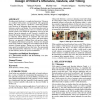Free Online Productivity Tools
i2Speak
i2Symbol
i2OCR
iTex2Img
iWeb2Print
iWeb2Shot
i2Type
iPdf2Split
iPdf2Merge
i2Bopomofo
i2Arabic
i2Style
i2Image
i2PDF
iLatex2Rtf
Sci2ools
HRI
2009
ACM
2009
ACM
Providing route directions: design of robot's utterance, gesture, and timing
Providing route directions is a complicated interaction. Utterances are combined with gestures and pronounced with appropriate timing. This study proposes a model for a robot that generates route directions by integrating three important crucial elements: utterances, gestures, and timing. Two research questions must be answered in this modeling process. First, is it useful to let robot perform gesture even though the information conveyed by the gesture is given by utterance as well? Second, is it useful to implement the timing at which humans speaks? Many previous studies about the natural behavior of computers and robots have learned from human speakers, such as gestures and speech timing. However, our approach is different from such previous studies. We emphasized the listener's perspective. Gestures were designed based on the usefulness, although we were influenced by the basic structure of human gestures. Timing was not based on how humans speak, but modeled from how they lis...
| Added | 19 May 2010 |
| Updated | 19 May 2010 |
| Type | Conference |
| Year | 2009 |
| Where | HRI |
| Authors | Yusuke Okuno, Takayuki Kanda, Michita Imai, Hiroshi Ishiguro, Norihiro Hagita |
Comments (0)

